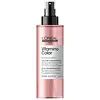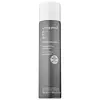What's inside
What's inside
 Key Ingredients
Key Ingredients

No key ingredients
 Benefits
Benefits

 Concerns
Concerns

 Ingredients Side-by-side
Ingredients Side-by-side

Water
Skin ConditioningCocos Nucifera Oil
MaskingAmodimethicone
Polyquaternium-37
Phenoxyethanol
PreservativePropylene Glycol Dicaprylate/Dicaprate
EmollientTocopherol
AntioxidantSodium Hydroxide
BufferingDimethicone PEG-7 Phosphate
CleansingPPG-1 Trideceth-6
Skin ConditioningTrideceth-6
EmulsifyingBehentrimonium Chloride
PreservativeXylose
HumectantLactic Acid
BufferingEthylhexylglycerin
Skin ConditioningLinalool
PerfumingSorbitan Oleate
EmulsifyingIsopropyl Alcohol
SolventCetrimonium Chloride
AntimicrobialHydrolyzed Vegetable Protein Pg-Propyl Silanetriol
Skin ConditioningResveratrol
AntioxidantBenzyl Alcohol
PerfumingLimonene
PerfumingCoumarin
PerfumingPotassium Sorbate
PreservativeParfum
MaskingWater, Cocos Nucifera Oil, Amodimethicone, Polyquaternium-37, Phenoxyethanol, Propylene Glycol Dicaprylate/Dicaprate, Tocopherol, Sodium Hydroxide, Dimethicone PEG-7 Phosphate, PPG-1 Trideceth-6, Trideceth-6, Behentrimonium Chloride, Xylose, Lactic Acid, Ethylhexylglycerin, Linalool, Sorbitan Oleate, Isopropyl Alcohol, Cetrimonium Chloride, Hydrolyzed Vegetable Protein Pg-Propyl Silanetriol, Resveratrol, Benzyl Alcohol, Limonene, Coumarin, Potassium Sorbate, Parfum
Alcohol Denat.
AntimicrobialHydrofluorocarbon 152a
Water
Skin ConditioningIsododecane
EmollientC13-15 Alkane
SolventDicaprylyl Ether
EmollientSunflower Seed Oil Glycerides
EmollientPolyquaternium-16
Dioleoylethyl Hydroxyethylmonium Methosulfate
Propylene Glycol Dibenzoate
Skin ConditioningIsohexadecane
EmollientTriheptanoin
Skin ConditioningPPG-5-Ceteth-20
EmulsifyingC13-16 Isoalkane
SolventPEG-40 Hydrogenated Castor Oil
EmulsifyingParfum
MaskingAminomethyl Propanol
BufferingLinalool
PerfumingCoumarin
PerfumingCitronellol
PerfumingGeraniol
PerfumingCitral
PerfumingLimonene
PerfumingAlcohol Denat., Hydrofluorocarbon 152a, Water, Isododecane, C13-15 Alkane, Dicaprylyl Ether, Sunflower Seed Oil Glycerides, Polyquaternium-16, Dioleoylethyl Hydroxyethylmonium Methosulfate, Propylene Glycol Dibenzoate, Isohexadecane, Triheptanoin, PPG-5-Ceteth-20, C13-16 Isoalkane, PEG-40 Hydrogenated Castor Oil, Parfum, Aminomethyl Propanol, Linalool, Coumarin, Citronellol, Geraniol, Citral, Limonene
Ingredients Explained
These ingredients are found in both products.
Ingredients higher up in an ingredient list are typically present in a larger amount.
Coumarins are a group of substances found naturally in plants. There are over 1300 types of coumarins identified. It has a natural vanilla scent.
Coumarin is an identified EU known allergy, meaning it may cause an allergic reaction when applied to the skin.
In many countries, coumarin is banned as a food additive. However, it can be found in soaps, tobacco products, and some alcohol drinks.
Plants use coumarins as a chemical defense. Some plants that have coumarins include lavender, tonka beans, and yellow clovers.
Learn more about CoumarinLimonene is a fragrance that adds scent and taste to a formulation.
It's found in the peel oil of citrus fruits and other plants such as lavender and eucalyptus. The scent of limonene is generally described as "sweet citrus".
Limonene acts as an antioxidant, meaning it helps neutralize free radicals.
When exposed to air, oxidized limonene may sensitize the skin. Because of this, limonene is often avoided by people with sensitive skin.
The term 'fragrance' is not regulated in many countries. In many cases, it is up to the brand to define this term. For instance, many brands choose to label themselves as "fragrance-free" because they are not using synthetic fragrances. However, their products may still contain ingredients such as essential oils that are considered a fragrance.
Learn more about LimoneneLinalool is a fragrance and helps add scent to products. It's derived from common plants such as cinnamon, mint, citrus, and lavender.
Like Limonene, this ingredient oxidizes when exposed to air. Oxidized linalool can cause allergies and skin sensitivity.
This ingredient has a scent that is floral, spicy tropical, and citrus-like.
Learn more about LinaloolParfum is a catch-all term for an ingredient or more that is used to give a scent to products.
Also called "fragrance", this ingredient can be a blend of hundreds of chemicals or plant oils. This means every product with "fragrance" or "parfum" in the ingredients list is a different mixture.
For instance, Habanolide is a proprietary trade name for a specific aroma chemical. When used as a fragrance ingredient in cosmetics, most aroma chemicals fall under the broad labeling category of “FRAGRANCE” or “PARFUM” according to EU and US regulations.
The term 'parfum' or 'fragrance' is not regulated in many countries. In many cases, it is up to the brand to define this term.
For instance, many brands choose to label themselves as "fragrance-free" because they are not using synthetic fragrances. However, their products may still contain ingredients such as essential oils that are considered a fragrance by INCI standards.
One example is Calendula flower extract. Calendula is an essential oil that still imparts a scent or 'fragrance'.
Depending on the blend, the ingredients in the mixture can cause allergies and sensitivities on the skin. Some ingredients that are known EU allergens include linalool and citronellol.
Parfum can also be used to mask or cover an unpleasant scent.
The bottom line is: not all fragrances/parfum/ingredients are created equally. If you are worried about fragrances, we recommend taking a closer look at an ingredient. And of course, we always recommend speaking with a professional.
Learn more about ParfumWater. It's the most common cosmetic ingredient of all. You'll usually see it at the top of ingredient lists, meaning that it makes up the largest part of the product.
So why is it so popular? Water most often acts as a solvent - this means that it helps dissolve other ingredients into the formulation.
You'll also recognize water as that liquid we all need to stay alive. If you see this, drink a glass of water. Stay hydrated!
Learn more about Water